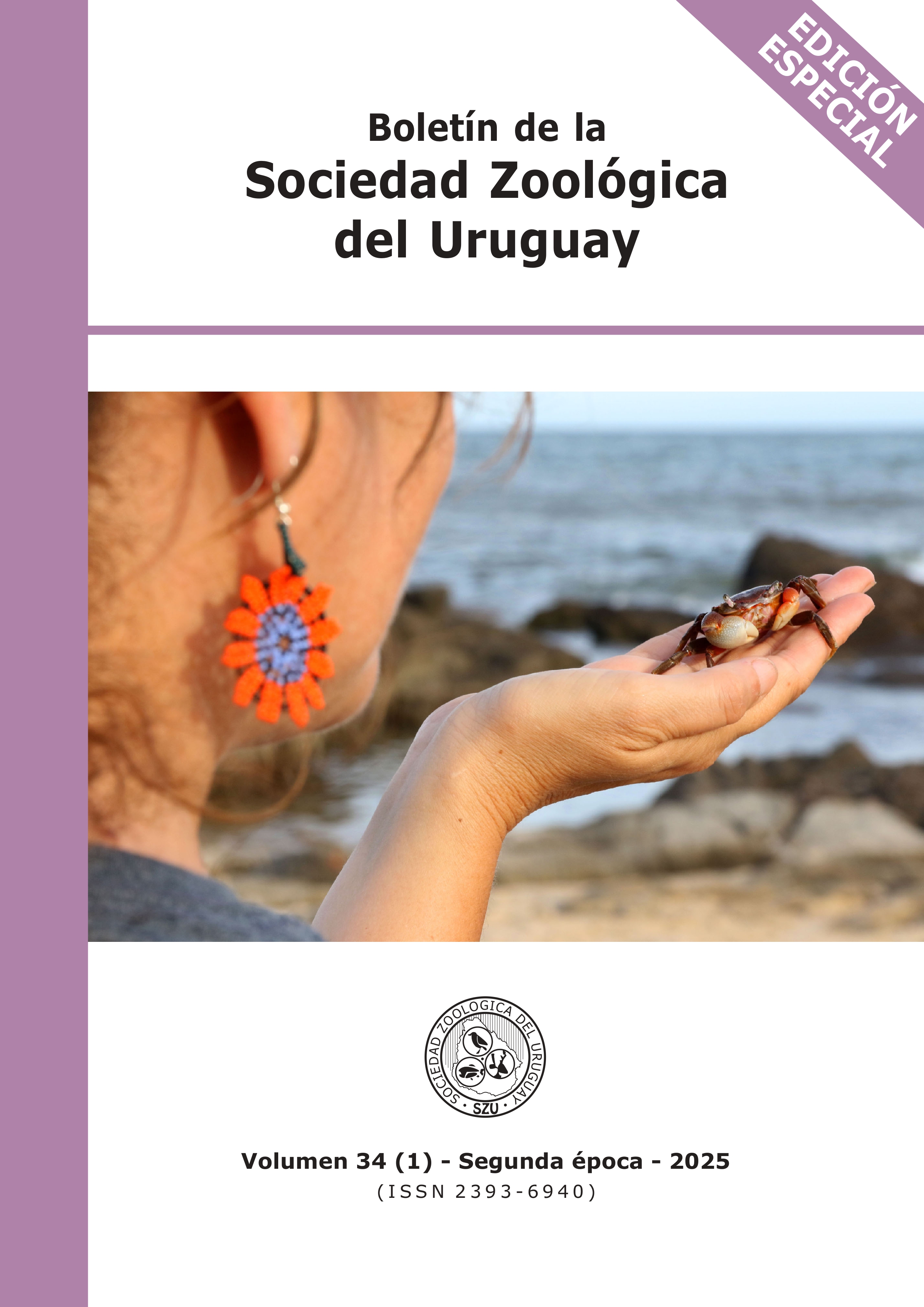DIFERENCIAS DE ESTACIONALIDAD REPRODUCTIVA ENTRE MORFOTIPOS CONTRASTANTES DE Megaleporinus obtusidens (TELEOSTEI: CHARACIFORMES) EN EL BAJO RÍO URUGUAY
DOI:
https://doi.org/10.26462/34.1.3Palabras clave:
Variación morfológica, morfometría geométrica, índice gonadosomático, Río UruguayResumen
La “boga” (Megaleporinus obtusidens) es un pez de importancia pesquera y ecológica en el río Uruguay con amplia plasticidad fenotípica y variación en su morfología. A pesar de ello, poco se conoce sobre su biología y ecología reproductiva. En este trabajo evaluamos la dinámica reproductiva de M. obtusidens de morfologías contrastantes en el bajo río Uruguay. Los peces fueron colectados mensualmente durante dos años, identificándose los individuos como Morfotipo 1 ("cuerpo alargado") o Morfotipo 2 ("cuerpo ovalado") (n=232). Se utilizó Morfometría Tradicional y Geométrica en un subconjunto de especímenes para testear diferencias morfológicas. Asimismo, se estimó y comparó el Índice Gonadosomático (GSI) entre morfotipos. El análisis morfométrico confirmó las diferencias entre morfotipos contrastantes. Los dos morfos exhibieron patrones reproductivos distintos: los individuos de Morfotipo 2 registraron GSI más alto en primavera, marcando un pico reproductivo en noviembre, mientras que los especímenes de Morfotipo 1 no mostraron diferencias en GSI entre estaciones. Este estudio muestra que hay dos morfos de M. obtusidens encontrados en el bajo Río Uruguay que pueden representar dos unidades taxonómicas diferentes o quizás dos stocks. Esto debería ser considerado en el manejo pesquero, para lograr un uso más sustentable de este recurso.
Descargas
Citas
Adams, D. C., & Otárola‐Castillo, E. (2013). geomorph: an R package for the collection and analysis of geometric morphometric shape data. Methods in ecology and evolution, 4(4), 393-399.
Anderson, M. J. (2014). Permutational multivariate analysis of variance (PERMANOVA). Wiley statsref: statistics reference online, 1-15.
Andrade, E. S., Felizardo, V. O., Murgas, L. D. S., Drumond, M. M., Zangerônimo, M. G., & Costa, S. F. (2013). Reproductive dynamics of Leporinus obtusidens captured downstream from an important hydropower Station in Brazil. Arquivo Brasileiro de Medicina Veterinária e Zootecnia, 65, 1419-1426.
Avigliano, E., Pisonero, J., Dománico, A., Silva, N., Sánchez, S., & Volpedo, A. V. (2018). Spatial segregation and connectivity in young and adult stages of Megaleporinus obtusidens inferred from otolith elemental signatures: Implications for management. Fisheries Research, 204, 239-244.
Begg, G. A., & Waldman, J. R. (1999). An holistic approach to fish stock identification. Fisheries research, 43: 35-44.
Britski, H. A., Birindelli, J. L. O., & Garavello, J. C. (2012). A new species of Leporinus Agassiz, 1829 from the upper Rio Paraná basin (Characiformes, Anostomidae) with redescription of L. elongatus Valenciennes, 1850 and L. obtusidens (Valenciennes, 1837). Papéis Avulsos de Zoologia, 52, 441-475.
Bonini‐Campos, B., Lofeu, L., Brandt, R., & Kohlsdorf, T. (2019). Different developmental environments reveal multitrait plastic responses in South American Anostomidae fish. Journal of Experimental Zoology Part B: Molecular and Developmental Evolution, 332(7), 238-244.
Boltovskoy, D., Xu, M., & Nakano, D. (2015). Impacts of Limnoperna fortunei on man-made structures and control strategies: general overview. Limnoperna fortunei: The ecology, distribution and control of a swiftly spreading invasive fouling mussel, 375-393.
Cadrin, S. X., & Friedland, K. D. (1999). The utility of image processing techniques for morphometric analysis and stock identification. Fisheries Research, 43(1-3), 129-139.
Carolsfeld, J., Harvey, B., Ross, C., & Baer, A. 2003. Migratory fishes of South America: biology, fisheries and conservation status. British Columbia: International Development Research Centre/World Bank/World Fisheries Trust. 372 p.
Cataldo, D., Leites, V., Bordet, F., & Paolucci, E. (2022). Effects of El Niño-Southern Oscillation (ENSO) on the reproduction of migratory fishes in a large South American reservoir. Hydrobiologia, 849(15), 3259-3274.
Cataldo, D., O'Farrell, I., Paolucci, E., Sylvester, F., & Boltovskoy, D. (2012). Impact of the invasive golden mussel (Limnoperna fortunei) on phytoplankton and nutrient cycling. Aquatic Invasions, 7(2).
Comisión Administradora del Río Uruguay (CARU) (2024). Principales vedas proyectadas para el año 2023 en el Río Uruguay. Recuperado de https://caru.org.uy/nuevositio/pesca/.
Delignette-Muller, M. L., & Dutang, C. (2015). fitdistrplus: An R package for fitting distributions. Journal of statistical software, 64, 1-34.
Dwivedi, A. K., & Dubey, V. K. (2013). RETRACTED ARTICLE: Advancements in morphometric differentiation: a review on stock identification among fish populations. Reviews in Fish Biology and Fisheries, 23, 23-39.
Dománico, A. (2021). Informe de relevamiento de la ictiofauna en el periodo invernal año 2021 y comparación con periodos invernales anteriores. Subprograma: relevamiento de la ictiofauna del Río Uruguay. Programa de conservación de la fauna íctica y los recursos pesqueros del Río Uruguay. CARU. 24 pp.
Duchini, D., Boltovskoy, D., & Sylvester, F. (2018). The invasive freshwater bivalve Limnoperna fortunei in South America: multiannual changes in its predation and effects on associated benthic invertebrates. Hydrobiologia, 817, 431-446.
Espinach Ros, A. (1999). Migraciones de peces en el río Uruguay. Primeras jornadas sobre conservación de la fauna íctica en el río Uruguay. Comisión Administradora del Río Uruguay-CARU, 52p, 13-14.
Felizardo, V. O., Murgas, L. D. S., Winkaler, E. U., Pereira, G. J. M., Drumond, M. M., & Andrade, E. S. (2011). Fator de condição relacionado a aspectos reprodutivos da piapara (Leporinus obtusidens) (Characiformes: Anostomidae) coletadas a jusante da Usina Hidrelétrica do Funil, Minas Gerais, Brasil. Ciência Animal Brasileira, 12(3), 471-477.
Fuentes, C. M., Lozano, I. E., & Vegh, S. L (2017). Actividad reproductiva de peces migratorios estimada a través del flujo de larvas. Índices de abundancia larval (IAL). Períodos 2014-2015 y 2015-2016, y análisis en retrospectiva 2008-2016. 75 pp.
Gatz, A. J. (1979). Ecological morphology of freshwater stream fishes. Tulane Studies of Zoology and Botany, 21, 91-124.
Greenacre, M., Groenen, P. J., Hastie, T., d’Enza, A. I., Markos, A., & Tuzhilina, E. (2022). Principal component analysis. Nature Reviews Methods Primers, 2(1), 100.
González‐Bergonzoni, I., Silva, I., Teixeira de Mello, F., D'Anatro, A., Boccardi, L., Stebniki, S., ... Naya, D. E. (2020). Evaluating the role of predatory fish controlling the invasion of the Asian golden mussel Limnoperna fortunei in a subtropical river. Journal of Applied Ecology, 57(4), 717-728.
González-Bergonzoni, I., Vidal, N., D’Anatro, A., Teixeira de Mello, F., Silva, I., & Naya, D. E. (2023). Historical analysis reveals ecological shifts in two omnivorous fish after the invasion of Limnoperna fortunei in the Uruguay river. Biological Invasions, 25(6), 1935-1954.
Griffith, H. (1994). Body elongation and decreased reproductive output within a restricted clade of lizards (Reptilia: Scincidae). Journal of Zoology, 233(4), 541-550.
Hahn, N.S.; Agostinho, A.A.; Gomes, L.C., & Bini, L.M. (1998). Estrutura trófica da ictiofauna do reservatório de Itaipu (Paraná-Brasil) nos primeiros anos de sua formação. Interciência, 23(5): 299-305.
Hartz, S. M., Silveira, C. M., Carvalho, S., & Villamil, C. (2000). alimentação da piava, Leporinus obtusidens (characiformes, anostomidae), no lago guaíba, porto alegre, Rio grande do sul, Brasil. Pesquisa agropecuária gaúcha, 6(1), 145-150.
Klingenberg, C. P. (2011). MorphoJ: an integrated software package for geometric morphometrics. Molecular ecology resources, 11(2), 353-357.
Machado‐Evangelista, M., EsguÍcero, A. L. H., Arcifa, M. S., & Pereira, T. N. A. (2015). Diet and ecomorphology of Leporinus reticulatus (Characiformes: Anostomidae) from the upper Rio Juruena, MT, Brazil: Ontogenetic shifts related to the feeding ecology. Acta Amazonica, 45, 383–392.
Marcus, L. F., & Corti, M. (1996). Overview of the new, or geometric morphometrics. In Advances in morphometrics (pp. 1-13). Boston, MA: Springer US.
Mitteroecker, P., & Bookstein, F. (2011). Linear discrimination, ordination, and the visualization of selection gradients in modern morphometrics. Evolutionary Biology, 38, 100-114.
Mounic-Silva, C. E., Lopes, C. A., Porto-Ferreira, L. B., Nunes, M. E., Reynalte-Tataje, D. A., & Zaniboni-Filho, E. (2019). Spawning and recruitment areas of migratory fish in the Uruguay River: applying for rivers connectivity conservation in South America. Boletim do Instituto de Pesca, 45(3).
Linares, M. S., Callisto, M., & Marques, J. C. (2017). Invasive bivalves increase benthic communities complexity in neotropical reservoirs. Ecological Indicators, 75, 279-285.
Loureiro, M., González-Bergonzoni, I., & Teixeira de Mello, F. (2023). Peces de Agua Dulce de Uruguay. Segunda Edición. Laboratorio de Zoología de Vertebrados, Facultad de Ciencias, Universidad de la República.
Loureiro M., Zarucki, M., González, I., Vidal, N., & Fabiano, G. (2013). Peces Continentales. En: Soutullo A, C Clavijo & Ja Martínez-Lanfranco (Eds). Especies prioritarias para la conservación en Uruguay. Vertebrados, moluscos continentales y plantas vasculares (Pp: 91-112). DINAMA, Montevideo, 222 pp.
Pietrusewsky, M. (2018). Traditional morphometrics and biological distance: methods and an example. Biological anthropology of the human skeleton, 545-591.
Quintana, C. F., Arbués, R., Sánchez, S., González, A., & Fontana, D. (2010). Fecundidad y desarrollo gonadal de la “boga” Leporinus obtusidens (Pisces, Anostomidae) en la represa Yacyretá, Argentina. Revista Veterinaria, 21(1), 48-54.
R Core Team (2024). What is R. https://www.r-project.org/about.html Accessed on March, 2024.
Ramírez, J. L., Birindelli, J. L., & Galetti Jr, P. M. (2017a). A new genus of Anostomidae (Ostariophysi: Characiformes): diversity, phylogeny and biogeography based on cytogenetic, molecular and morphological data. Molecular phylogenetics and evolution, 107, 308-323.
Ramírez, J. L., Birindelli, J. L., Carvalho, D. C., Affonso, P. R., Venere, P. C., Ortega, H., ... Galetti Jr, P. M. (2017b). Revealing hidden diversity of the underestimated neotropical ichthyofauna: DNA barcoding in the recently described genus Megaleporinus (Characiformes: Anostomidae). Frontiers in Genetics, 8, 149.
Rohlf, F. J. (2017). TpsDig2, version 2.30. Department of Ecology and Evolution, State University of New York at Stony Brook.
Rovira, M. (2017). Análisis filogeográfico de la boga Leporinus obtusidens (Characiformes, Anostomidae) a lo largo de su rango de distribución en las cuencas del Río Uruguay y el Río Paraná.
Rueden, C. T., Schindelin, J., Hiner, M. C., DeZonia, B. E., Walter, A. E., Arena, E. T., & Eliceiri, K. W. (2017). ImageJ2: ImageJ for the next generation of scientific image data. BMC bioinformatics, 18, 1-26.
Sidlauskas, B. L., & Vari, R. P. (2008). Phylogenetic relationships within the South American fish family Anostomidae (Teleostei, Ostariophysi, Characiformes). Zoological Journal of the Linnean Society, 154, 70–210.
Silva, N. A. (2017). Dinámica poblacional de la boga (Megaleporinus obtusidens Valenciennes, 1837) en relación con el régimen hídrico. 113 pp.
Silva, I., Naya, D., Teixeira de Mello, F., D’Anatro, A., Tesitore, G., Clavijo, C., & González-Bergonzoni, I. (2021a). Fish vs. Aliens: predatory fish regulate populations of Limnoperna fortunei mitigating impacts on native macroinvertebrate communities. Hydrobiologia, 848, 2281-2301.
Silva, I., Brugnoli, E., Clavijo, C., D’Anatro, A., Naya, D. E., de Mello, F. T., ... González-Bergonzoni, I. (2021b). Interacciones entre el mejillón dorado y macroinvertebrados bentónicos nativos del Río Uruguay. Innotec, (22).
Zúñiga‐Vega, J. J., Suárez‐Rodríguez, M., Espinosa‐Pérez, H., & Johnson, J. B. (2011). Morphological and reproductive variation among populations of the Pacific molly Poecilia butleri. Journal of Fish Biology, 79(4), 1029-1046.
Zuur, A. F., Ieno, E. N., & Elphick, C. S. (2010). A protocol for data exploration to avoid common statistical problems. Methods in ecology and evolution, 1(1), 3-14.
Vazzoler, A. E. A. M. 1996. Biologia da reprodução de peixes teleósteos: teoria e prática. Maringá, Editora da Universidade, 169p.
Višnjić-Jeftić, Ž., Lenhardt, M., Vukov, T., Gačić, Z., Skorić, S., Smederevac-Lalić, M., & Nikčević, M. (2013). The geometric morphometrics and condition of Pontic shad, Alosa immaculata (Pisces: Clupeidae) migrants to the Danube River. Journal of Natural History, 47(15-16), 1121-1128.
Viñas, J., Gordoa, A., Fernández-Cebrián, R., Pla, C., Vahdet, Ü., & Araguas, R. M. (2011). Facts and uncertainties about the genetic population structure of Atlantic bluefin tuna (Thunnus thynnus) in the Mediterranean. Implications for fishery management. Reviews in Fish Biology and Fisheries, 21(3), 527-541.
Wudneh, T. (1998). Biology and management of fish stocks in Bahir dar Gulf, Lake Tana, Ethiopia. Wageningen University and Research.











